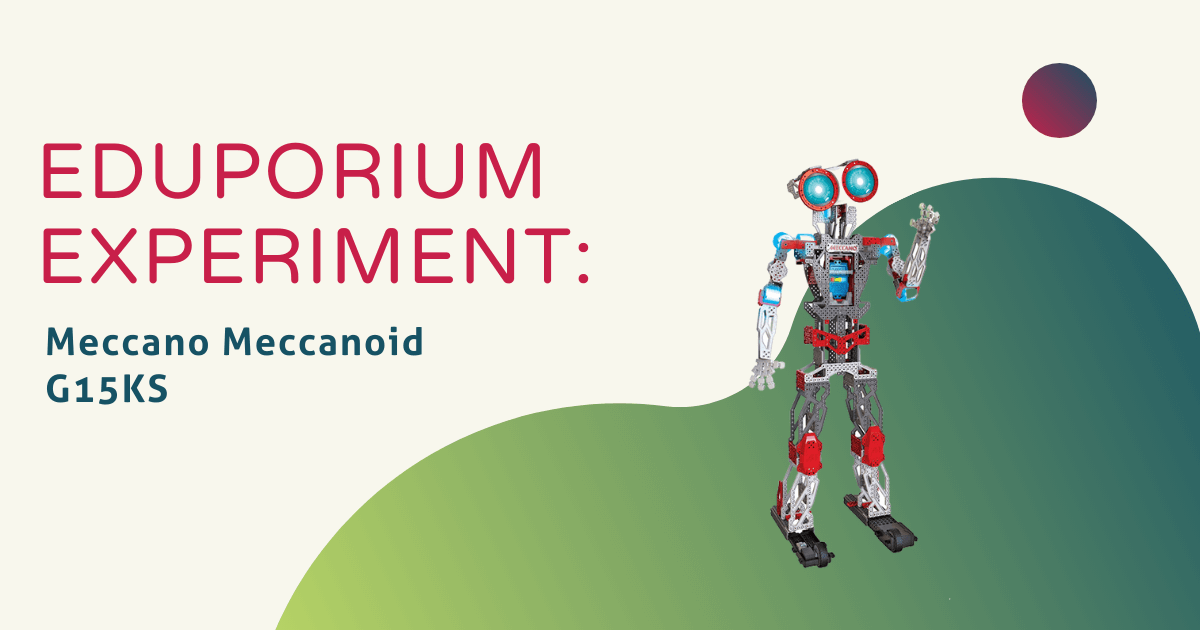When you think of STEM education, one of the first fields that probably jumps to mind is the expansive and exciting field of robotics. It’s a widely-accepted fact that robotics education is critical to building 21st century STEM skills because it combines so many essential disciplines, like coding, engineering, technology, mathematics, and many more, depending on what each specific robot can do.
I grew up building things—my favorite toys were ones I got to assemble myself (I always opted for the most complicated LEGO Bionicle sets, for example, on the rare occasion that I had the opportunity to get one). Eventually this love of getting my hands dirty led me to my middle school’s LEGO FIRST Robotics team, and then naturally onto my high school’s FIRST team (#2423, the KwarQs). I bring up my own history with robotics because it’s very relevant to this week’s Eduporium Experiment, which features the Meccano Meccanoid G15KS, one of the most complex and involved robots and building projects we have available in the Eduporium store!
Just from looking at the box, I could tell that Meccano does not mess around. This particular robot stands about four feet tall when completely assembled (and I do mean assembled—more on that in a moment), and boasts amazing voice recognition capabilities, knows over 1,000 pre-programmed phrases, comments, and witty comebacks, and features realistic movements. According to Meccano, “when you build a Meccanoid G15KS Personal Robot, you’re building a friend.” The robot comes completely disassembled (containing over 1,000 pieces), and presents the challenge of not only programming a robot, but building it as well. It might now be easy to see why I mentioned my experiences with FIRST Robotics—this Experiment promised to take me back!
Busting the Meccanoid out of the box (a week in advance of writing this article), I could tell right away that this project was going to take some time. Full disclosure? I’m still not done with it, but the experience has been a very positive one so far, save the frustrations I’ve experienced with getting it assembled in a timely fashion (my full-time position at Eduporium is unfortunately not “Robot Assembler,” so I’ve been devoting time to putting it together between my other tasks as Office Manager).
I’m the kind of person who enjoys baking and following recipes, so assembling the Meccanoid was right up my alley. It comes with a fully colored and illustrated instruction booklet, which takes the engineer through the process of building their robot step-by-step. Also, the instructions are all visual with no reading required (so it’s kind of like putting together IKEA furniture, if you’ve ever been on that kind of adventure before).
At the point that I’m writing this post, I’m estimating that my Meccanoid is about 75 percent completed. I’ve fully assembled its upper half and right now I’m working on its legs, which I believe are the last structural aspect I’ll need to assemble. Then, it’s on to connecting all the wires and getting the ‘bot up and running at which point I’ll be able to start testing its capabilities.
So, what are my opinions on the Meccanoid at this point? Mostly positive. Here’s why: I believe that building a complex piece of technology is a great learning experience for anyone, and, if students get the opportunity to build a project like this one, they will definitely be able to draw on what they learn for the rest of their lives. In building a complex bot like the Meccanoid robots, kids will also develop attention to detail and patience—the pieces are very well-engineered, but there are no shortcuts. Nothing snaps together (because that wouldn’t be secure), and nothing is pre-built; they need to do it all themselves. The Meccano team provides all the supplies, but it’s going to take a lot of time to screw everything together before it actually starts working with its programming.
That said, I would recommend the Meccanoid G15KS more for students in the older grades (junior high and up). I know I would have lost patience with building it, but after that I would have relished the challenge and the chance to do something that felt “real.” The kit also doesn’t feel “kid-ified.” The pieces feel solid, and the screws are really screws, plus all of the electrical bits need to be handled like real pieces of tech.
That’s the other reason I think this kit is better suited for older students: it requires users to have a basic understanding of technology to really appreciate what the Meccanoid is trying to teach them. There’s no doubt, however, that building their own robot is going to teach students a lot about how it works and why. When they start working with their Meccanoid, they will be able to see the physical connections they built, which allow data and electricity to flow.
I’m pretty excited to continue working on this robot. I really want to get to the point where I can test out its speech-recognition and motion-capture capabilities and see what other educational opportunities it could offer in a 21st century classroom. I like the idea of having a human-sized robot friend around the office. Maybe we can use it to give tours of our techXplore room! You never know.
If you have an idea for a product you’d like to see featured on the Eduporium Experiment or want to let us know what you thought about this one, let us know! Send us a message on Twitter or Facebook!



